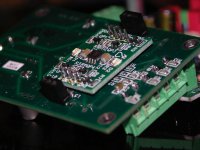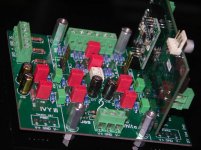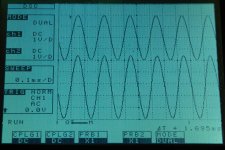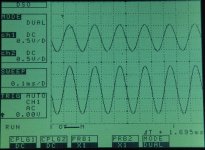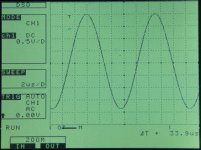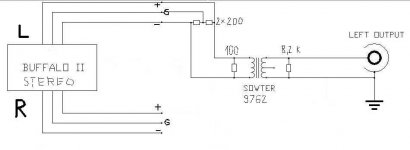Just to put my 2 cents and sign to the club of BuffaloII & Transformers.
P.S.
If I could suggested to TP the only “right way” of mounting the AVC Shunt reg is of cause GLT way 😉.
This should be in Buffalo manual, specially when except of listening to Your DAC You intent to make an photo of it 😉.
All the best
Rosendorfer
Hi Rosendorfer, thanks for the support 🙂 but that's just me because I also like taking pictures of the projects.
Some questions on the transformers: are you using them as Balanced to SE converters? Regarding the impedance of the transformer, does the DAC sees the 9.2 ohm static resistance (meaning very little voltage swing) or the >1K impedance (meaning much larger voltage swing).
Seeing so much interest with transformers, perhaps TPA can do some testing and custom build/order transformers just like Crystek custom builds the clocks for TPA
Last edited:
Mount AVCC on top or bottom. Technically neither is more right than the other. It is just a matter of which position is most practical for you. 🙂
When using IVY-III or Legato, mounting AVCC on the bottom will not be very practical.
When using transformers choose which ever you prefer. 😎
Cheers!
Russ
When using IVY-III or Legato, mounting AVCC on the bottom will not be very practical.
When using transformers choose which ever you prefer. 😎
Cheers!
Russ
Supporting GLT way of AVCC mounting as the “right one”
Dear Russ
Supporting GLT way of AVCC mounting as the “right one” was just my humble suggestion.
It accidentally happen to fit perfectly “practical” with IVY as You can see 😀 and I keep my fingers crossed it will be OK with Legato as definitely I'm looking forward to it.
As for technical reasons one could say that Sabre IC is getting just bit worm and having more "open air" does not hurts.
And You have to agree that this way Buffalo looks much better.😀
This is just innocent OT and excuse for me so I could post some more pictures.😉 and I hope You will not take it very serious.
All the best.
Dear Russ
Supporting GLT way of AVCC mounting as the “right one” was just my humble suggestion.
It accidentally happen to fit perfectly “practical” with IVY as You can see 😀 and I keep my fingers crossed it will be OK with Legato as definitely I'm looking forward to it.
As for technical reasons one could say that Sabre IC is getting just bit worm and having more "open air" does not hurts.
And You have to agree that this way Buffalo looks much better.😀
This is just innocent OT and excuse for me so I could post some more pictures.😉 and I hope You will not take it very serious.
All the best.
Attachments
Buffalo and LL1517
Dear GLT
Supporting You is my "privilege".😀
But getting back to Buffalo and LL1517 or any other transformers. It seems that I have to "support" You again as definitely it would be very nice if somebody more knowledgeable with this subject could share some light on this. As Russ is explaining Sabre works as current output DAC only when DAC sees IMPEDANCE close to zero. And this with any type of transformers is probably not possible and 10 Ohm of LL1517 RDC is not relevant in this case.
I'm not trafo expert it is my first experience with them so I will not be making any theory what is better or "right".
I did made some measurements of my Buffalo connected directly to LL1517 in 1:1 /serial primary- serial secondary/ working with different load resistor at trafo secondary.
On first picture:
CH1 working with 1kohm load and CH2 with 2 kohm load.
On second picture:
CH1 is working with 100 Ohm and CH2 with 200 Ohm Load.
As some additional test for me quite surprising what this Lundahl's are capable there is 90 Khz (!!!) sine ruining through them with 1Kohm load.
As You can see Buffalo is giving really lot of voltage or power for any needs.
From My experience Buffalo and LL1517 works extremely well even as Head Amp for HD650 (300 Ohm) plenty of power with amazing bas. And also with HD550 (60 Ohm) (!!!).
If there is any test You or any of the guys is interested please let me know I will try to do what I can with my setup.
All the best
Dear GLT
Supporting You is my "privilege".😀
But getting back to Buffalo and LL1517 or any other transformers. It seems that I have to "support" You again as definitely it would be very nice if somebody more knowledgeable with this subject could share some light on this. As Russ is explaining Sabre works as current output DAC only when DAC sees IMPEDANCE close to zero. And this with any type of transformers is probably not possible and 10 Ohm of LL1517 RDC is not relevant in this case.
I'm not trafo expert it is my first experience with them so I will not be making any theory what is better or "right".
I did made some measurements of my Buffalo connected directly to LL1517 in 1:1 /serial primary- serial secondary/ working with different load resistor at trafo secondary.
On first picture:
CH1 working with 1kohm load and CH2 with 2 kohm load.
On second picture:
CH1 is working with 100 Ohm and CH2 with 200 Ohm Load.
As some additional test for me quite surprising what this Lundahl's are capable there is 90 Khz (!!!) sine ruining through them with 1Kohm load.
As You can see Buffalo is giving really lot of voltage or power for any needs.
From My experience Buffalo and LL1517 works extremely well even as Head Amp for HD650 (300 Ohm) plenty of power with amazing bas. And also with HD550 (60 Ohm) (!!!).
If there is any test You or any of the guys is interested please let me know I will try to do what I can with my setup.
All the best
Attachments
Thats absolutely amazing. Out of interest would you predict similar results using an LL1690 or one of the amorphous cored options from lundahl?
Dear GLT
Supporting You is my "privilege".😀
But getting back to Buffalo and LL1517 or any other transformers. It seems that I have to "support" You again as definitely it would be very nice if somebody more knowledgeable with this subject could share some light on this. As Russ is explaining Sabre works as current output DAC only when DAC sees IMPEDANCE close to zero. And this with any type of transformers is probably not possible and 10 Ohm of LL1517 RDC is not relevant in this case.
I'm not trafo expert it is my first experience with them so I will not be making any theory what is better or "right".
I did made some measurements of my Buffalo connected directly to LL1517 in 1:1 /serial primary- serial secondary/ working with different load resistor at trafo secondary.
On first picture:
CH1 working with 1kohm load and CH2 with 2 kohm load.
On second picture:
CH1 is working with 100 Ohm and CH2 with 200 Ohm Load.
As some additional test for me quite surprising what this Lundahl's are capable there is 90 Khz (!!!) sine ruining through them with 1Kohm load.
As You can see Buffalo is giving really lot of voltage or power for any needs.
From My experience Buffalo and LL1517 works extremely well even as Head Amp for HD650 (300 Ohm) plenty of power with amazing bas. And also with HD550 (60 Ohm) (!!!).
If there is any test You or any of the guys is interested please let me know I will try to do what I can with my setup.
All the best
Indeed AVCC does seem to fit quite well on the bottom side even when used with the IVY-III. 🙂
I am certainly going to second the idea that it will will work quite well when mounted as you have done(that is directly so that the profile is short). 🙂
There is also something to be said for direct soldering. It is the best possible connection.
Cheers!
Russ
I am certainly going to second the idea that it will will work quite well when mounted as you have done(that is directly so that the profile is short). 🙂
There is also something to be said for direct soldering. It is the best possible connection.
Cheers!
Russ
Avian
As for LL1690 I can only speculate that it will be working just fine. Sabre can hapily work with Curent Output and with Voltage Output so it seems that almoust any trafo will be working. But if it is "the right" trafo that will give You the best possible resoults with Buffalo I have got no idea.
As for LL1690 I can only speculate that it will be working just fine. Sabre can hapily work with Curent Output and with Voltage Output so it seems that almoust any trafo will be working. But if it is "the right" trafo that will give You the best possible resoults with Buffalo I have got no idea.
Rosendorfer,
Thanks for the info. I have to admit that I had my doubt about fitting both IVY and AVCC in the bottom. I mainly wanted to solder the AVCC and still see the Sabre chip 🙂. Regarding the photos for the trafo, thus it seems the resistance in the secondaries is reflected on the primaries... (corresponding to the winding ratio).
Thanks for the info. I have to admit that I had my doubt about fitting both IVY and AVCC in the bottom. I mainly wanted to solder the AVCC and still see the Sabre chip 🙂. Regarding the photos for the trafo, thus it seems the resistance in the secondaries is reflected on the primaries... (corresponding to the winding ratio).
I did measure trafo secondary with different loads. If You find this interesting to test I can try to measure trafo input and output.
What I'm looking for, right now is the question how to find the "optimal" load resistance. Maybe 195-200 Ohm , if I understand Russ correctly, this is output impedance of Buffalo, so maybe “impedance matching” would be the “optimal”, or should I go the way of pushing Sabre more into Curent Output by lowering the load resistance gaining in theory less distortion, but then I'm afraid dynamics could be badly hurt. Any advise on this anyone.?
What I'm looking for, right now is the question how to find the "optimal" load resistance. Maybe 195-200 Ohm , if I understand Russ correctly, this is output impedance of Buffalo, so maybe “impedance matching” would be the “optimal”, or should I go the way of pushing Sabre more into Curent Output by lowering the load resistance gaining in theory less distortion, but then I'm afraid dynamics could be badly hurt. Any advise on this anyone.?
I think with 1:1 trafo you should use Buffalo in voltage mode (high load on secondaries) because in current mode you have to make DAC to see extremely low impedance and with 1:1 trafo it is possible with extremely secondary load and extremely low output amplitude.....
I think you should connect trafo to Buffalo and do not use any output resistor - connect directly to your amp.
Voltage mode is theoretically worse in specs than current mode but diffirence is totally unaudible because ultra low THD isn't discriminant of sound quality. -108 vs -120 really doesn't metter.
I think you should connect trafo to Buffalo and do not use any output resistor - connect directly to your amp.
Voltage mode is theoretically worse in specs than current mode but diffirence is totally unaudible because ultra low THD isn't discriminant of sound quality. -108 vs -120 really doesn't metter.
-108 THD in Voltage mode
Hi Marek
I would be bit carefully firmly stating this nice numbers. -108 THD in Voltage mode is ESS Sabre number and no doubt this is true, but I'm afraid this is not necessary number at Trafo output(!!).
I did some measurements with my EMU202 and they doesn't looks like -108 THD at trafo output (!!!). I wouldn't call them reliable enough to post but
If anyone else did measurements of Buffalo with trafos and could share would be nice to confirm the numbers. My EMU could be wrong. 🙂.
As for not loading trafo output, again from my uncertified(!!) measurements seems that this influences specially low frequencies response (20-200Hz) of trafo . And at list 1Kohm trafo load is probably about minimum to have.
Rosendorfer
Hi Marek
I would be bit carefully firmly stating this nice numbers. -108 THD in Voltage mode is ESS Sabre number and no doubt this is true, but I'm afraid this is not necessary number at Trafo output(!!).
I did some measurements with my EMU202 and they doesn't looks like -108 THD at trafo output (!!!). I wouldn't call them reliable enough to post but
If anyone else did measurements of Buffalo with trafos and could share would be nice to confirm the numbers. My EMU could be wrong. 🙂.
As for not loading trafo output, again from my uncertified(!!) measurements seems that this influences specially low frequencies response (20-200Hz) of trafo . And at list 1Kohm trafo load is probably about minimum to have.
Rosendorfer
Hi Marek
I would be bit carefully firmly stating this nice numbers. -108 THD in Voltage mode is ESS Sabre number and no doubt this is true, but I'm afraid this is not necessary number at Trafo output(!!).
I did some measurements with my EMU202 and they doesn't looks like -108 THD at trafo output (!!!). I wouldn't call them reliable enough to post but
If anyone else did measurements of Buffalo with trafos and could share would be nice to confirm the numbers. My EMU could be wrong. 🙂.
As for not loading trafo output, again from my uncertified(!!) measurements seems that this influences specially low frequencies response (20-200Hz) of trafo . And at list 1Kohm trafo load is probably about minimum to have.
Rosendorfer
Hi Rosendorfer. You could compare the 3 configurations: straight from DAC, trafo and Ivy.
It is technically possible but ....
Dear GLT
I'm afraid that measuring Buffalo+IVY with EMU202 isn't good idea. EMU is not able to do anything in the range of that parts and the results will tel more about my power supply than the IVY. So it is technically possible but posting this kind of measurement in TP thread wouldn't be at list "wise".
Regarding "straight from DAC" voltage out, EMU202 is simple SE stuff I would need something with balanced inputs, /maybe EMU404 I do not remember if it has balanced inputs/ to make any THD measurements. Basically we need something to convert differential to single ended. In theory I could try to modifie IVY for higher imput impedance but to be honest idea of desoldering resistors from my "presious" IVY is not realy tempting. The second option is nice Trafo from Lundahl 🙂.
I realy do not wish to sound negative but how in reliable way measure Bufalo in Voltage Output with EMU202 I'm puzled. Anyway in any idea I'm open. There will be "long weekend" this weekend so I could find some time.
All the best
Rosendorfer
Dear GLT
I'm afraid that measuring Buffalo+IVY with EMU202 isn't good idea. EMU is not able to do anything in the range of that parts and the results will tel more about my power supply than the IVY. So it is technically possible but posting this kind of measurement in TP thread wouldn't be at list "wise".
Regarding "straight from DAC" voltage out, EMU202 is simple SE stuff I would need something with balanced inputs, /maybe EMU404 I do not remember if it has balanced inputs/ to make any THD measurements. Basically we need something to convert differential to single ended. In theory I could try to modifie IVY for higher imput impedance but to be honest idea of desoldering resistors from my "presious" IVY is not realy tempting. The second option is nice Trafo from Lundahl 🙂.
I realy do not wish to sound negative but how in reliable way measure Bufalo in Voltage Output with EMU202 I'm puzled. Anyway in any idea I'm open. There will be "long weekend" this weekend so I could find some time.
All the best
Rosendorfer
Marek
Yes I did use the RMAA v5.5 and 6.2.
During the wekend I can try to use ARTA to check if the measurments are the same and will see if they will get relliable enought to post if this is interesting to you.
Yes I did use the RMAA v5.5 and 6.2.
During the wekend I can try to use ARTA to check if the measurments are the same and will see if they will get relliable enought to post if this is interesting to you.
You would need something much better than any sound card FFT to get accurate enough measurements for the IVY III.
RMAA is good software, but the ADC will be the weak link.
You would need something like an Audio Precision or similar.
Otherwise the noise and THD of the measuring device itself will dominate and you won't have any very useful data.
Cheers!
Russ
RMAA is good software, but the ADC will be the weak link.
You would need something like an Audio Precision or similar.
Otherwise the noise and THD of the measuring device itself will dominate and you won't have any very useful data.
Cheers!
Russ
Last edited:
In any case I will quote myself
Russ
In any case I will quote myself:
"measuring Buffalo+IVY with EMU202 isn't good idea. EMU is not able to do anything in the range of that parts and the results will tel more about my power supply than the IVY. So it is technically possible but posting this kind of measurement in TP thread wouldn't be at list "wise". " 😀
OK
Just was thinking about way of making my distortion measurements bit more reliable, without need of buying AP. I did checked AP web but I decided to save some money for second Buffalo and Legato, if TP will still be kind to sell to me. 🙂
So
I have a look at Lundahl web page, there is LL1517 datasheat
http://lundahl.se/pdfs/datash/1517.pdf
and it is clearly stated that :
>>>>
Distortion (achieved with mixed feedback drive circuit, load 600 OHM.......... < 0.03 % @ 20 dBU, 30Hz
>>>>
Acording : http://www.sengpielaudio.com/calculator-thd.htm
0,03% is -70.4dB
Maybe that's why bas produced by trafos is so "big"; litle help from strong harmonics..??
30Hz (!!) is probably something like Worst Case Scenario.
Trafo THD depends on frequency so 30Hz THD is not the same as 1kHz THD.
But again this is the number with special Opamp based (!!!) mixed feedback(!!) circuit.
See: "mixed feedback drive circuit":
http://lundahl.se/pdfs/papers/feedbck.pdf
What is the real THD “number” will depend on trafo working conditions like input and output impedance and measured frequency, so I'm afraid “single number” THD is no go.
But we probably can agree /If there was any dispute on this/ that THD at trafo output is not the same as Sabre output and not even close to -108dB ( 0.0003981 % ).
I wouldn't like to sound like somebody that fights trafos, it is oposite.
I'm just trying to find the best possible way of connecting this two, with just lite bit of "know-how".
Russ
If You would be kind enough and have a look at the “mixed feedback circuit” from Lundahl web and post any comments about possibility of adapting this kind of circuit to be used with Buffalo, this could be very interesting.
All the best
Rosendorfer
Russ
In any case I will quote myself:
"measuring Buffalo+IVY with EMU202 isn't good idea. EMU is not able to do anything in the range of that parts and the results will tel more about my power supply than the IVY. So it is technically possible but posting this kind of measurement in TP thread wouldn't be at list "wise". " 😀
OK
Just was thinking about way of making my distortion measurements bit more reliable, without need of buying AP. I did checked AP web but I decided to save some money for second Buffalo and Legato, if TP will still be kind to sell to me. 🙂
So
I have a look at Lundahl web page, there is LL1517 datasheat
http://lundahl.se/pdfs/datash/1517.pdf
and it is clearly stated that :
>>>>
Distortion (achieved with mixed feedback drive circuit, load 600 OHM.......... < 0.03 % @ 20 dBU, 30Hz
>>>>
Acording : http://www.sengpielaudio.com/calculator-thd.htm
0,03% is -70.4dB
Maybe that's why bas produced by trafos is so "big"; litle help from strong harmonics..??
30Hz (!!) is probably something like Worst Case Scenario.
Trafo THD depends on frequency so 30Hz THD is not the same as 1kHz THD.
But again this is the number with special Opamp based (!!!) mixed feedback(!!) circuit.
See: "mixed feedback drive circuit":
http://lundahl.se/pdfs/papers/feedbck.pdf
What is the real THD “number” will depend on trafo working conditions like input and output impedance and measured frequency, so I'm afraid “single number” THD is no go.
But we probably can agree /If there was any dispute on this/ that THD at trafo output is not the same as Sabre output and not even close to -108dB ( 0.0003981 % ).
I wouldn't like to sound like somebody that fights trafos, it is oposite.
I'm just trying to find the best possible way of connecting this two, with just lite bit of "know-how".
Russ
If You would be kind enough and have a look at the “mixed feedback circuit” from Lundahl web and post any comments about possibility of adapting this kind of circuit to be used with Buffalo, this could be very interesting.
All the best
Rosendorfer
Pleas repost the drawing with the correct values?
Thanks
Thanks
I'm sorry, primary resistance, 100 ohms Delete
- Status
- Not open for further replies.
- Home
- More Vendors...
- Twisted Pear
- Buffalo II & transformers
